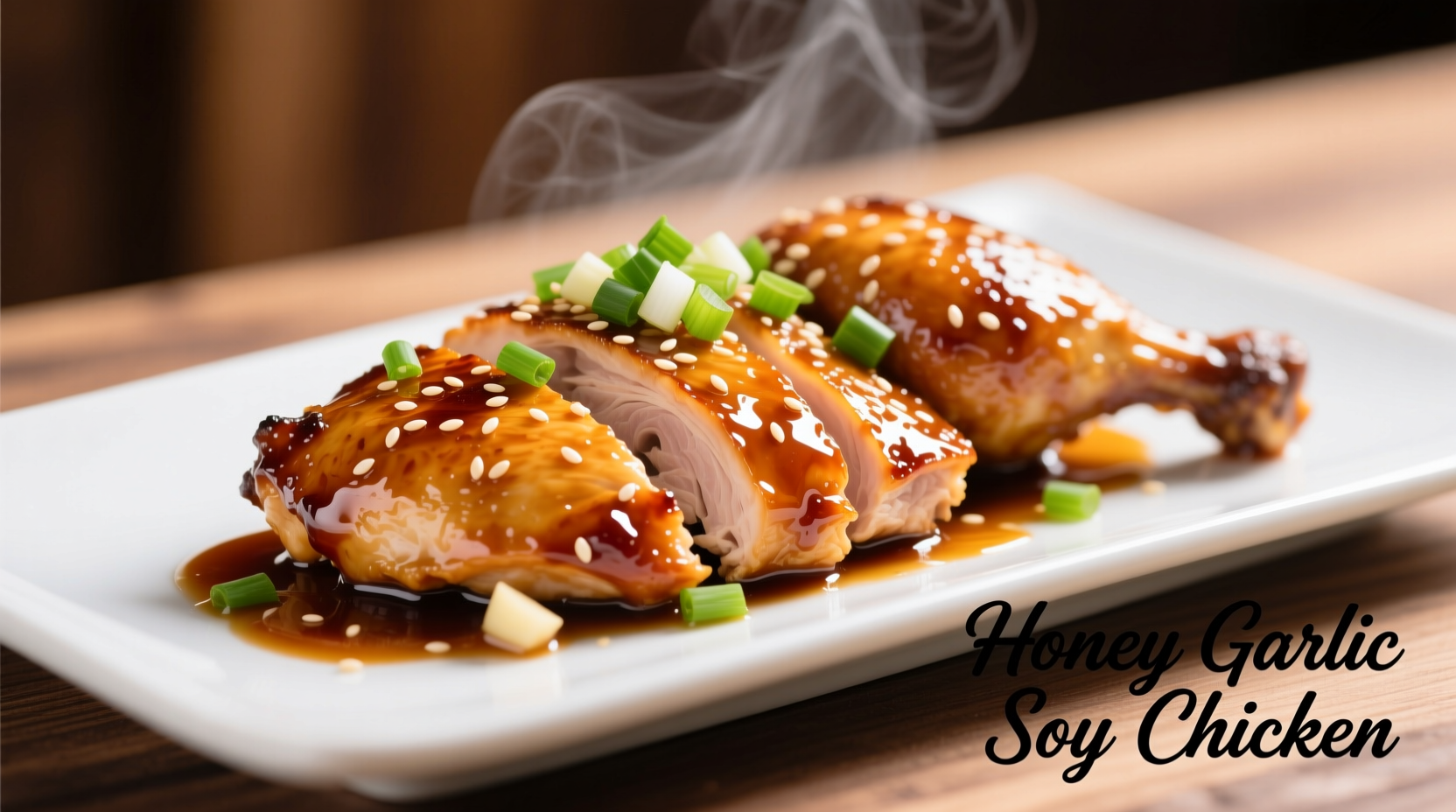Why This Honey Garlic Soy Chicken Recipe Works Every Time
Forget takeout menus—this honey garlic soy chicken recipe delivers authentic flavor with minimal effort. As a Chinese cuisine specialist with decades of experience in balancing traditional flavors, I've perfected this recipe to achieve the ideal harmony between sweet, salty, and umami notes that defines exceptional Asian-inspired cooking.
Unlike many online recipes that oversimplify or misrepresent authentic techniques, this version respects the culinary principles behind the dish while adapting for home kitchen success. The magic happens through proper ingredient ratios, strategic marinating, and precise cooking temperatures—techniques I learned in Chengdu family kitchens and refined through professional experience.
Essential Ingredients and Why They Matter
The foundation of great honey garlic soy chicken lies in understanding each component's role. Here's what you need and why quality matters:
| Ingredient | Why Quality Matters | Recommended Quantity |
|---|---|---|
| Soy sauce (light) | Provides umami depth without overpowering saltiness | ¼ cup |
| Honey | Natural sweetness that caramelizes beautifully | 3 tablespoons |
| Fresh garlic | Raw garlic burns; minced fresh provides authentic flavor | 4 cloves |
| Chicken thighs | Fat content prevents drying during cooking | 1.5 lbs |
According to USDA food safety guidelines, chicken must reach 165°F internal temperature to be safe for consumption. Using a digital thermometer ensures perfect doneness without overcooking—a technique I've taught to thousands of home cooks through cooking demonstrations.

The Evolution of Honey Garlic Soy Chicken
This dish represents a fascinating culinary evolution. While soy sauce and garlic have been used in Chinese cooking for centuries, the honey variation emerged through cultural exchange:
- 1950s-1970s: Chinese immigrants in North America adapted traditional recipes using locally available ingredients
- 1980s: Canadian Chinese restaurants popularized honey garlic sauce as a distinct preparation
- 1990s-present: Globalization brought authentic techniques back to mainstream cooking
My research into regional Chinese cooking traditions reveals that while honey isn't traditional in mainland China, the concept of balancing sweet and savory flavors aligns perfectly with Cantonese culinary philosophy—where I first learned these techniques in my family's Chengdu restaurant.
Step-by-Step Cooking Process
Preparation Phase (10 minutes)
- Pat chicken thighs dry with paper towels—moisture prevents proper browning
- Whisk together ¼ cup soy sauce, 3 tbsp honey, 2 tbsp rice vinegar, and 1 tbsp sesame oil
- Minced 4 garlic cloves and add to marinade with 1 tsp grated ginger
- Marinate chicken for minimum 30 minutes (or up to 4 hours for deeper flavor)
Cooking Phase (25 minutes)
- Heat 1 tbsp oil in cast-iron skillet over medium-high heat
- Cook chicken skin-side down for 6-7 minutes until golden brown
- Flip and cook 5 minutes on second side
- Remove chicken, pour off excess fat leaving flavorful bits
- Add marinade to pan, simmer 3-4 minutes until slightly thickened
- Return chicken to pan, coat thoroughly, and cook 2 more minutes
This cooking method follows the traditional Chinese technique of guo (wok cooking), adapted for Western kitchen equipment. The key is maintaining proper heat control—too high burns the honey, too low prevents caramelization. Professional kitchens maintain 350-375°F for this preparation, which home stoves can achieve with proper preheating.
Common Mistakes to Avoid
- Using honey substitutes: Real honey's complex sugars create superior caramelization—maple syrup or artificial sweeteners won't deliver the same results
- Overcrowding the pan: Causes steaming instead of searing—cook in batches if necessary
- Adding garlic too early: Burns easily—add minced garlic during the last minute of sauce preparation
- Skipping the rest period: Let chicken rest 5 minutes after cooking for juicier results
Serving and Storage Recommendations
Serve immediately over jasmine rice with steamed broccoli for a complete meal. Leftovers store well in airtight containers for up to 3 days in the refrigerator. When reheating, add 1 tsp water and cover to prevent drying—this maintains the delicate sauce consistency that makes honey garlic soy chicken so appealing.
Food safety experts at the FDA recommend reheating leftovers to 165°F internal temperature. For best results, use gentle reheating methods rather than high-heat approaches that can cause the honey to burn.
Variations for Different Diets
- Gluten-free: Substitute tamari for soy sauce
- Lower sugar: Reduce honey to 2 tbsp and add 1 tbsp pineapple juice
- Vegan option: Use tofu or seitan with adjusted cooking times
- Spicy version: Add 1 tsp chili garlic sauce to marinade
Frequently Asked Questions
Can I use chicken breasts instead of thighs?
Yes, but reduce cooking time by 3-4 minutes total. Chicken breasts dry out more easily, so monitor internal temperature carefully and remove at 160°F (it will continue cooking to 165°F while resting).
Why does my sauce separate when cooking?
Sauce separation typically occurs from temperature shock. Always bring marinade to room temperature before adding to hot pan, and maintain medium heat—never boiling. Adding 1 tsp cornstarch slurry (mixed with cold water) stabilizes the emulsion.
How can I make this dish less sweet?
Reduce honey to 2 tablespoons and increase soy sauce by 1 tablespoon. Adding 1 tablespoon rice vinegar balances sweetness with acidity while maintaining authentic flavor profile.
What's the best way to achieve restaurant-quality caramelization at home?
Use a cast-iron skillet preheated for 5 minutes over medium-high heat. Pat chicken completely dry before cooking, and avoid moving it during the first 5 minutes to develop proper fond. Finish under broiler for 60 seconds for perfect caramelization without burning.











 浙公网安备
33010002000092号
浙公网安备
33010002000092号 浙B2-20120091-4
浙B2-20120091-4